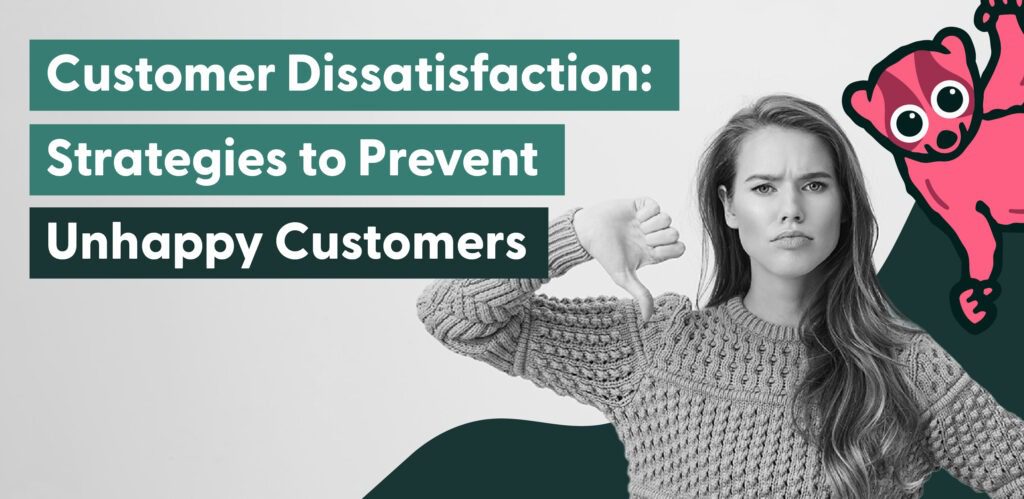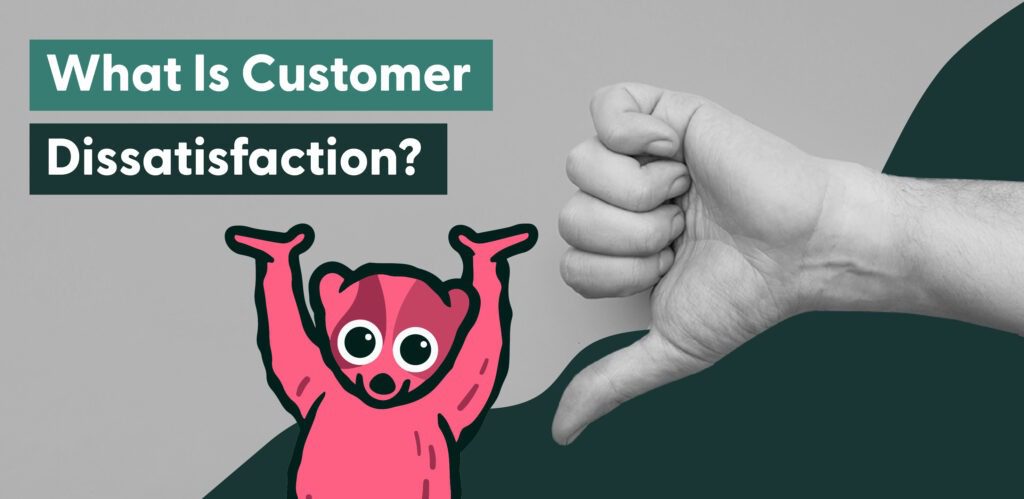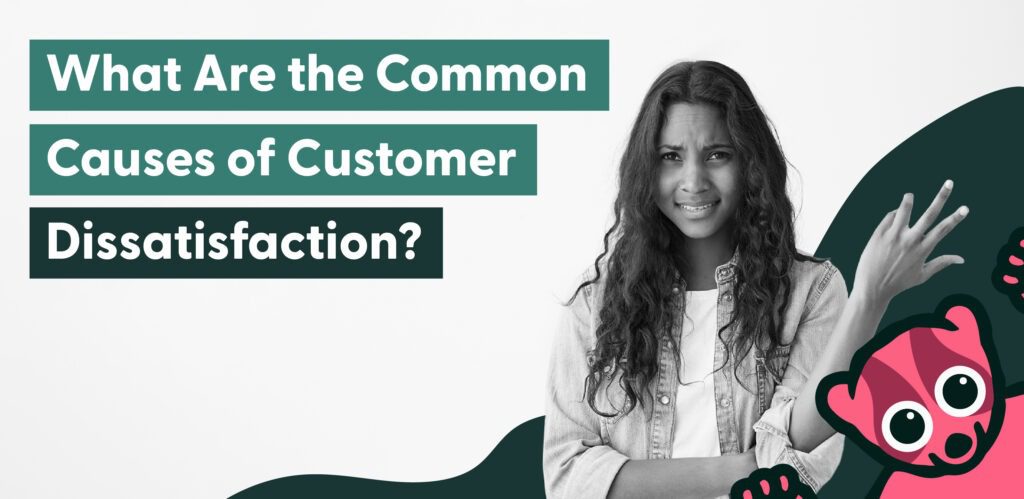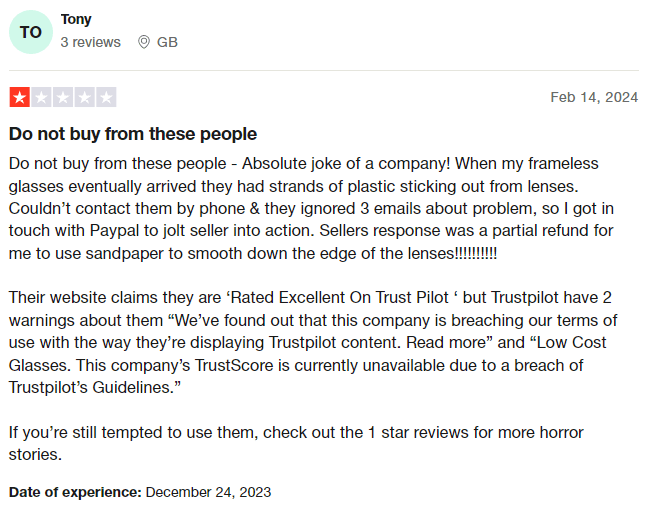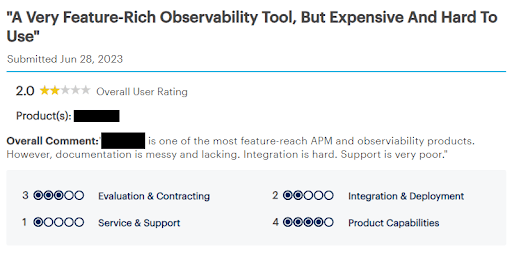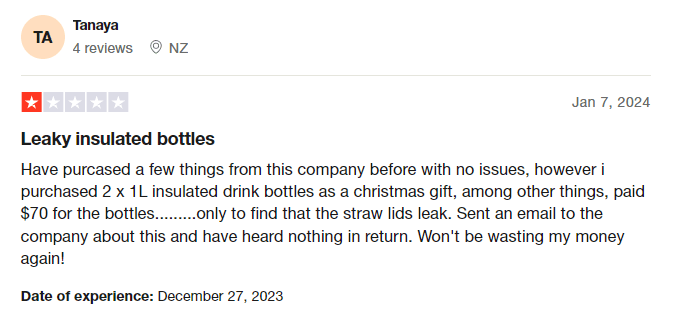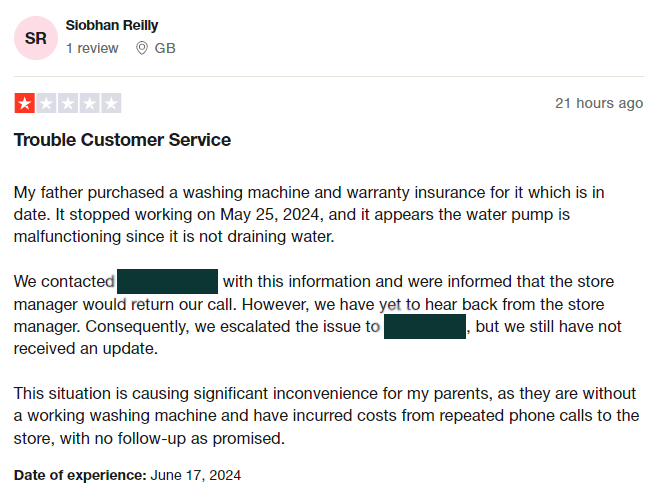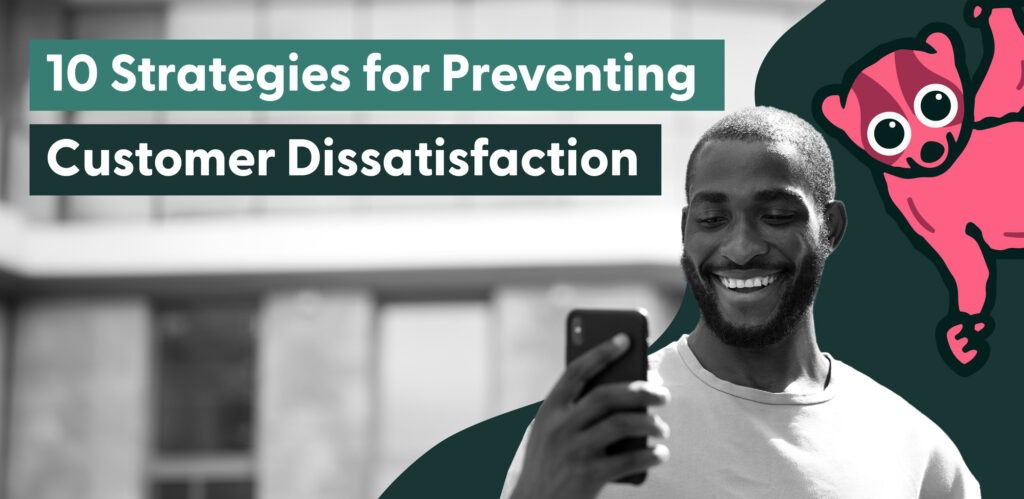Customer dissatisfaction isn’t a minor issue. In some cases, it can ruin your entire brand. Online complaints that can’t be removed could tarnish your reputation for good. And future customers will consider alternatives.
The UK Royal Mail is a good example of how dissatisfied customers can impact your business. They lost their 360-year monopoly on parcel delivery from post office sites due to poor customer service and missing delivery targets—eek!
When customer satisfaction goes wrong, it can impact your entire business.
To avoid customer dissatisfaction and drive customer loyalty, you need to implement the right strategies.
In this article, we’ll guide you through the common causes of customer dissatisfaction and how it can impact your business. We’ll also share some useful strategies to avoid customer dissatisfaction.
What Is Customer Dissatisfaction?
Customer dissatisfaction is when your product or service doesn’t meet the expectations or needs of your customers.
This can make customers feel disappointed, frustrated, or angry about your brand. The problem with this is that it can take 12 positive customer experiences to make up for just one negative experience.
Customer dissatisfaction can result in:
👎 Complaints.
👎 Negative reviews.
👎 Reduced loyalty and retention.
👎 Customers switching to a competitor.
In fact, 65% of customers change to different brands because of a poor experience. And, only one in five customers will forgive a company for a bad experience.
If you don’t prioritize managing customer dissatisfaction, it can impact your sales, marketing, and customer service efforts. It can also significantly affect your bottom line.
What Are the Common Causes of Customer Dissatisfaction?
Here are the most common reasons why customers become unhappy with a brand:
❌ Quality
If your product or customer experience (CX) is low quality, you can expect customers to be unhappy. They expect value for money, and a low-quality product is the quickest way to disappoint them.
A common mistake brands make is overpromising on quality. What you tell your customers about the value of your product should never exceed what you deliver.
This customer posted on an online review website about poor quality glasses. The brand in question has received several complaints about low-quality products, damaging its reputation:
❌ Pricing
A big price tag often means a product is of high value. If you’re not delivering this value, you could quickly end up with unhappy customers.
This customer felt that the features of this product offers are good. But because the software was poor in several other areas, they felt they weren’t getting value for money:
❌ Not meeting customer expectations
The way you present your product to customers sets expectations. Product descriptions on your website, for example, tell customers what they can and should expect from their purchase.
But if your product doesn’t meet the expectations you’ve promised through your marketing, it’s likely customers will complain and potentially choose a competitor over you.
This customer was promised high-quality water bottles, which she expected to receive. Instead, she received water bottles that leaked:
❌ Usability
If your product isn’t user-friendly, you’ll likely receive complaints about this, as customers will be frustrated.
This is why it’s important to keep track of customer feedback so you can fix issues with your product—we’ll discuss this later in this article.
Here’s an online review from a customer expressing their dissatisfaction with the usability of the software they purchased.
The customer service from the software provider was good, but because the UX is poor, they gave it just two stars and said they were unlikely to recommend it:
❌ Customer service issues
Your contact center is the heart of your business. It’s the first point of engagement that unhappy customers have with your brand.
If you’re not delivering excellent customer service when people call, email, or chat with you, you can expect them to become dissatisfied.
Here’s an example from a customer who tried contacting a brand’s customer service and never received a response:
What Happens if You Don’t Address a Dissatisfied Customer?
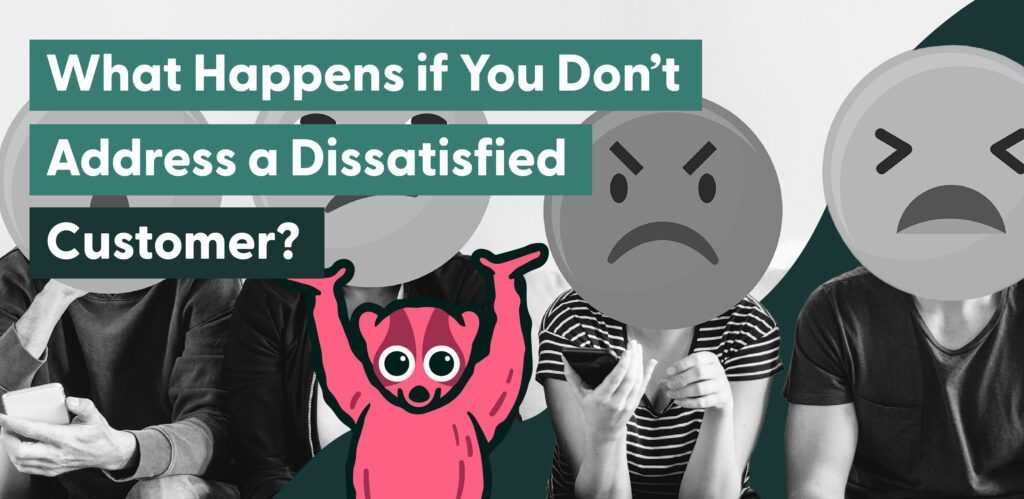
Here’s what happens if you don’t address customer dissatisfaction and complaints:
⚠️ Negative word of mouth
If customers become angry, they won’t hesitate to take their complaints public. They’re likely to share their negative experiences with others, as seen in the online reviews above.
In the digital age, a single negative review or social media post can reach a large audience, damaging your reputation on a wide scale.
In fact, 13% of dissatisfied customers will share their experience with 15 or more other people. And 87% of consumers will reverse a purchase decision after reading negative reviews about a business online.
⚠️ Loss of customers
U.S. businesses lose more than $62 billion annually due to poor customer service.
If your customers aren’t happy with the level of customer service you offer, this can lead to customers leaving your business for competitors who offer better services or quality.
In fact, 91% of unhappy customers will leave a brand without even complaining. Poor service and experience means you could be losing customers without knowing about it.
Even if they don’t leave immediately, dissatisfied customers are less likely to remain loyal to your brand. They’ll be more easily swayed by competitive offers.
⚠️ Decreased revenue
Your revenue drops as customers leave your business or choose not to continue making purchases.
Happy customers often refer others to your brand, but dissatisfied ones don’t. This could lead to lower customer acquisition, which is costly to your business. Investing in new customers is between five and 25 times more expensive than retaining existing ones.
One study found that businesses that focus on delivering an excellent customer experience have seen an 80% increase in revenue.
⚠️ Increased costs
Unresolved issues can lead to more extensive and costly complaint handling later on. Not dealing with issues quickly can result in more returns, exchanges, or refunds. This increases your operating costs.
⚠️ A damaged reputation
A brand that becomes known for poor customer service or a low-quality product can suffer long-term reputational damage. If you develop a negative image, attracting or retaining new customers is harder. Over 90% of customers choose not to purchase from a company due to a poor reputation.
10 Strategies for Preventing Customer Dissatisfaction
Now that you know more about customer dissatisfaction, here are some practical strategies you can follow to minimize unhappy customers:
1. Adopt a customer-first approach
When you’re wrapped up in business strategy and product design, it’s difficult to dedicate time and resources to serving your customers the way you’d like.
Their needs, preferences, and pain points should be what drives your business. This includes your product, processes, and customer service.
Rather than only considering profitability and growth, you should prioritize understanding your customers and providing them with solutions and support.
Here’s how you can do this:
💡 Regularly gather and analyze customer feedback. This can be done through surveys, for example.
💡 Use social listening to monitor your social media and online reviews to understand customer sentiment and respond to their concerns.
💡 Continuously improve your business and update your product based on customer feedback to meet or exceed their expectations.
Adopting a customer-first approach could lead to something called the service recovery paradox (SRP). This is when a customer becomes more loyal to your brand because you’ve fixed an emerging issue right away, even if they haven’t experienced an issue with another brand.
Let’s say your invoicing services website goes down for several hours, costing your customers money. Identifying the root cause, fixing this issue immediately, and offering your clients compensation in some form could lead to the SRP.
It could result in customers being happier with your business and more loyal to it than they would’ve been if no problem had occurred, because of how your business handled the issue.
This is a good example of how fixing emerging issues quickly and spotting the root cause of a problem can turn dissatisfied customers into loyal ones.
2. Prioritize customer feedback in your decision-making
Your contact center is an excellent source of business insights. Essentially, your customers tell you what is good and bad about your company.
You can use these insights to inform decision-making and make improvements across your business (and provide better customer service).
You can prioritize customer feedback by:
💡 Sorting feedback into categories such as product quality, service experience, and pricing for targeted analysis.
💡 Using a conversation intelligence platform like Loris to analyze all your customer interactions to derive actionable insights that help you make better decisions.
3. Continuously improve your product
If you know what your customers say about your product, you can make meaningful improvements to it.
Again, this starts with the customer feedback. If your customer insights reveal that your product is hard to use, you know you need to improve usability.
It’s not enough to launch a product and hope for the best. You should use customer insights to improve your product and continuously meet customer needs.
Here’s how you can continuously improve your product:
💡 Gather customer feedback to find out what they don’t like about your product so you can improve this.
💡 Find out what customers like about your product so that you can double down on these features.
💡 Implement continuous testing during the product development process to identify and fix issues early.
4. Ensure your sales and marketing teams set clear expectations
Sales and marketing teams often make bold claims to attract customers. This is their job. But these claims need to be true or backed by evidence.
Ensure your sales and marketing efforts accurately communicate the value of your product.
Don’t mislead customers into making a purchase by making statements about your product that aren’t true.
You can ensure you set clear expectations by:
- Providing detailed and accurate product descriptions that include all your product features, specifications, and benefits.
- Clearly displaying pricing information, including any additional fees or charges.
- Clearly communicating the terms and conditions associated with purchases.
5. Ensure your policies are clear and fair
Your policies must be fair and easy for your customers to understand if you want to avoid dissatisfaction.
Let’s say you’re an eCommerce retailer, and your exchange policy isn’t clear. As a result, some customers are unable to swap products they don’t want or aren’t happy with.
These customers may not shop with you again as there is too much risk they will be stuck with something they don’t want or need. They may even post negative reviews online that you can’t get rid of.
You can ensure your policies are clear and fair by:
💡 Using plain language that is easy to understand, avoiding jargon and complex terms.
💡 Keeping your policies concise and to the point to avoid overwhelming customers with too much information
💡 Providing examples within your policies to clarify how they apply in real-life scenarios.
6. Make your processes more efficient
Having efficient processes can improve your customers’ overall experience with your brand. Your processes play an important role in avoiding frustration and improving customer loyalty.
Here’s how your efficient processes can help:
💡 Any process that reduces waiting times, like streamlined checkout or faster delivery, can enhance customer experience and avoid dissatisfaction.
💡 Automation like chatbots on your website can ensure smoother customer interactions, reducing the friction customers may experience during their journey.
💡 Consistent and reliable processes create predictable and positive outcomes, helping to meet customer expectations.
7. Understand customer sentiment
Customer sentiment is how your customers feel about your brand. Customer sentiment can be negative or positive.
Data from your support center can help you understand what is driving negative sentiment. This will give you actionable insights that you can use to improve the issues they’re complaining about.
If you know what creates a positive sentiment among your customers, you know how to avoid disappointing them.
You can understand customer sentiment by:
💡 Using sentiment analysis tools to analyze customer feedback.
💡 Using natural language processing (NLP) to understand the context and nuances of customer feedback.
💡 Setting up automated monitoring to continuously track and report on sentiment trends in real-time.
Traditional sentiment analysis tools are flawed. They typically only provide analysis based on a sample of customer interactions and require manual input from analysts. In addition, many operate on a very basic 3-point scale, which doesn’t provide the level of insight to separate an annoyed customer from an enraged one.
Loris is a conversation intelligence platform that analyzes all your customer interactions to determine broad factors driving customer dissatisfaction, like low sentiment or specific issues, rather than just looking at a few conversations.
8. Identify weak points in your customer service
The customer service you provide can make or break your business. Anytime customers don’t receive the answers they need at the speed they expect, they’ll become frustrated.
You can identify weak points in several ways:
- Gather customer feedback to pinpoint where your customer service is falling short. Things like call resolution times and escalations can help you identify what you need to improve.
- You can use this data to improve your service department and customer satisfaction.
- With an AI-powered platform like Loris, you don’t need to send out surveys and collect feedback manually. Instead, our platform analyzes every customer interaction to collect these insights for you.
9. Coach your support agents effectively
Coaching your agents on the issues that arise frequently in your contact center is vital. If your agents aren’t equipped to quickly and comprehensively resolve customer complaints and inquiries, you’ll end up with dissatisfied customers.
The best way to coach agents is to use examples of recent customer interactions. The most recent examples are the ones they’ll remember. Using a call from months ago to coach your agents won’t be helpful as they won’t remember the details of the call.
Traditional customer service software may provide you with some data about what to coach your agents on. However, a conversation intelligence platform like Loris can provide deep insights to help you coach your agents on the most important issues.
Some tips for coaching your contact center agents include:
💡 Encouraging an open dialogue where agents feel comfortable discussing challenges and seeking advice.
💡 Focus your coaching sessions on one topic at a time.
💡 Celebrating achievements and improvements to boost morale and motivation
10. Stay a step ahead (or a few steps ahead)
It can be difficult for customer service managers to spot patterns in customer interactions and identify wider issues.
Many customers may contact you with the same minor issue, but will you notice this trend and resolve the problem quickly enough? Or will it become a problem that affects hundreds of customers?
With a platform like Loris, you can get real-time insights from your customer interactions that will alert you to any issues that arise. With this information, you can address emerging problems quickly before they become a disaster for your reputation.
Increase Customer Satisfaction the Right Way with Loris
The best way to manage customer dissatisfaction is to understand what makes your customers unhappy. But how do you get this insight?
The answer lies in your customer interactions. If you’re monitoring your calls, emails, and live chats, you can get real-time insights on what’s going wrong and what you need to fix.
Loris is an AI-powered conversation intelligence platform that provides accurate and in-depth insights by analyzing every customer interaction you receive.
These insights can be used throughout your entire business to provide your customers with a better experience, reducing customer dissatisfaction. Speak to one of our experts to learn more about how Loris can help you keep your customers happy with the right insights.
